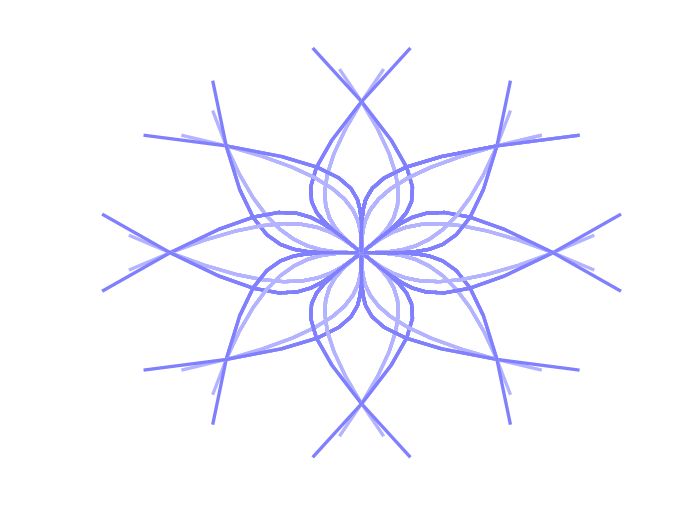Using rotated lines
Mathematically speaking, snowflakes have two very important properties: they are symmetric and they are random. Let's try to harness those two properties to create 'realisitic' looking snowflakes.
So how do we make a snowflake symmetric? The simplest way to make something rotationally symmetric is to rotate it! Let's just start with an arbitrary line, say from (1,1) to (2,2).
figure
plot([1,2],[1,3],'k-','LineWidth',5)
hold on
xlim([-5,5]);
ylim([-5,5]);
xlabel('x');
ylabel('y');
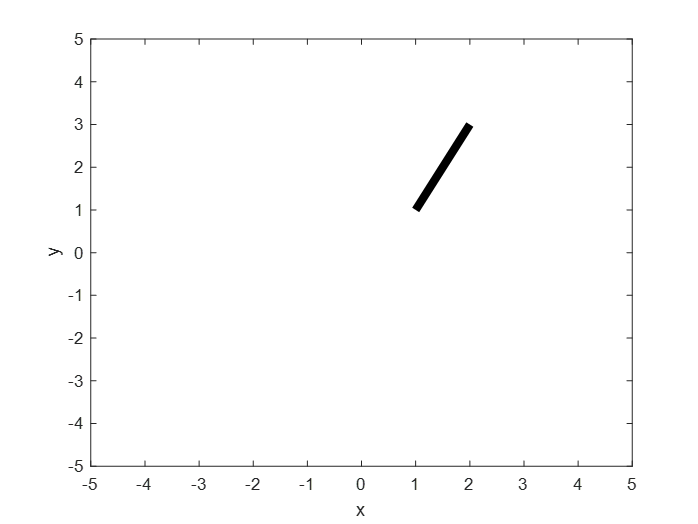
Now let's rotate that line about the origin every 30 degrees. How do we rotate a line about the origin? The answer is quite simple. First, you take the rotation matrix:

You replace theta with whatever angle you want to rotate by- in our case 30 degrees. Then you multiply the vectors representating the endpoints of your line by this rotation matrix to get the endpoints of your new, rotated line as follows:

figure
plot([1,2],[1,3],'k-','LineWidth',5)
hold on
xlim([-5,5]);
ylim([-5,5]);
xlabel('x');
ylabel('y');
pt1=[cosd(30) -sind(30);sind(30) cosd(30)]*[1;1];
pt2=[cosd(30) -sind(30);sind(30) cosd(30)]*[2;3];
plot([pt1(1),pt2(1)],[pt1(2),pt2(2)],'k-','LineWidth',5)
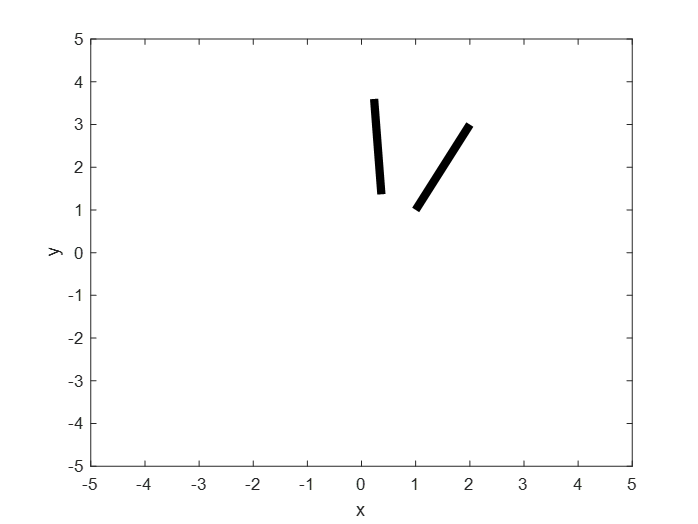
Now let's continue this pattern around the circle. To do so, we'll want to make our code more streamlined. So we introduce a for loop to draw our 'snowflake.'
figure
for ang=0:30:330
pt1=[cosd(ang) -sind(ang);sind(ang) cosd(ang)]*[1;1];
pt2=[cosd(ang) -sind(ang);sind(ang) cosd(ang)]*[2;3];
plot([pt1(1),pt2(1)],[pt1(2),pt2(2)],'k-','LineWidth',5)
hold on
xlim([-5,5]);
ylim([-5,5]);
xlabel('x');
ylabel('y');
end
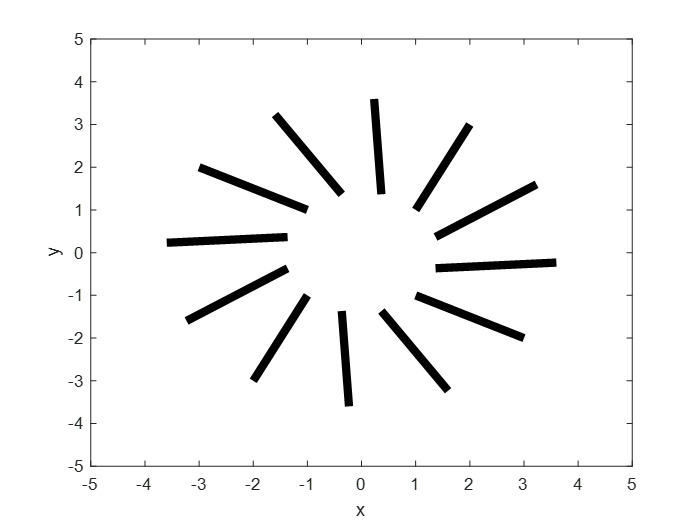
Alright, so we've successfully made a symmetric snowflake! But every time we run this code, we'll get the exact same snowflake! How can we add some variation?
The easiest way is to take advantage of Matlab's rand command, which generates a random number between 0 and 1. So to get a random number between zero and 2, you just say 2*rand, etc. We can use this to make the endpoints of our initial line random.
figure
orig1=[4*rand;4*rand];
orig2=[4*rand;4*rand];
for ang=0:30:330
pt1=[cosd(ang) -sind(ang);sind(ang) cosd(ang)]*orig1;
pt2=[cosd(ang) -sind(ang);sind(ang) cosd(ang)]*orig2;
plot([pt1(1),pt2(1)],[pt1(2),pt2(2)],'k-','LineWidth',5)
hold on
xlim([-5,5]);
ylim([-5,5]);
xlabel('x');
ylabel('y');
end
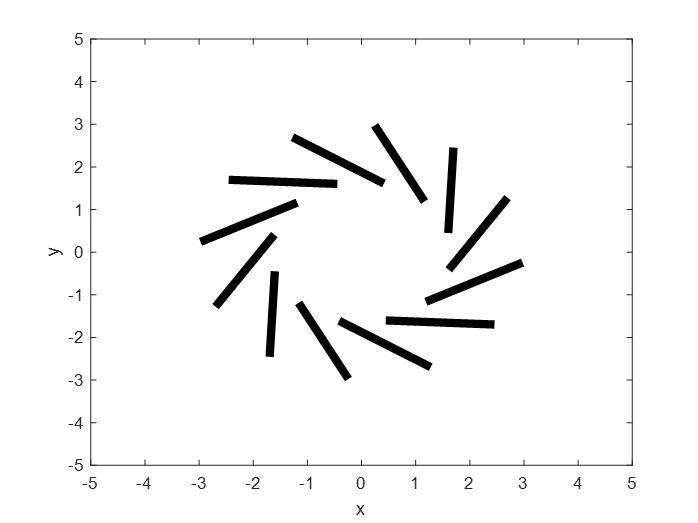
Okay, now let's try adding more lines!
figure
numlines=5;
orig1=zeros(2,2*numlines);
for i=1:2*numlines
orig1(:,i)=[4*rand;4*rand];
end
for ang=0:30:330
R=[cosd(ang) -sind(ang);sind(ang) cosd(ang)];
for i=1:2:2*numlines-1
pt1=R*orig1(:,i);
pt2=R*orig1(:,i+1);
plot([pt1(1),pt2(1)],[pt1(2),pt2(2)],'k-','LineWidth',5)
hold on
end
xlim([-5,5]);
ylim([-5,5]);
xlabel('x');
ylabel('y');
end

Here's the final, more polished code. Try running this- play around with setting the color, or the number of lines.
% Generate a 700x700 figure
fig1=figure('Position',[10,10,700,700]);
% Set up the plot parameters
plot(0,0)
radius=10000;
hold on
xlim([-radius*1.5,radius*1.5]);
ylim([-radius*1.5,radius*1.5]);
axis off
% This creates a matrix that will hold the line values for the snowflake
% The second dimension is a random number between 10 and 25-- twice the total number of lines in the snowflake
v1=zeros(2,round(rand*15+10));
% This loop fills your array with random numbers between 0 and radius
for i=1:size(v1,2)
v1(:,i)=[radius*rand,radius*rand];
end
% Cycle through the desired angles and draw the snowflake
for ang=0:60:300
% This is the rotation matrix
rot=[cosd(ang), -sind(ang); sind(ang), cosd(ang)];
for i=1:2:size(v1,2)-1
vtemp1=rot*v1(:,i); % Point 1
vtemp2=rot*v1(:,i+1); % Point 2
% Plot the line at a given angle
m=plot([vtemp1(1),vtemp2(1)],[vtemp1(2),vtemp2(2)],'Color',[.5*rand+.4,.5*rand+.4,.9],'LineWidth',10);
pause(0.01)
end
end
Here are some examples of snowflakes generated with the above program!
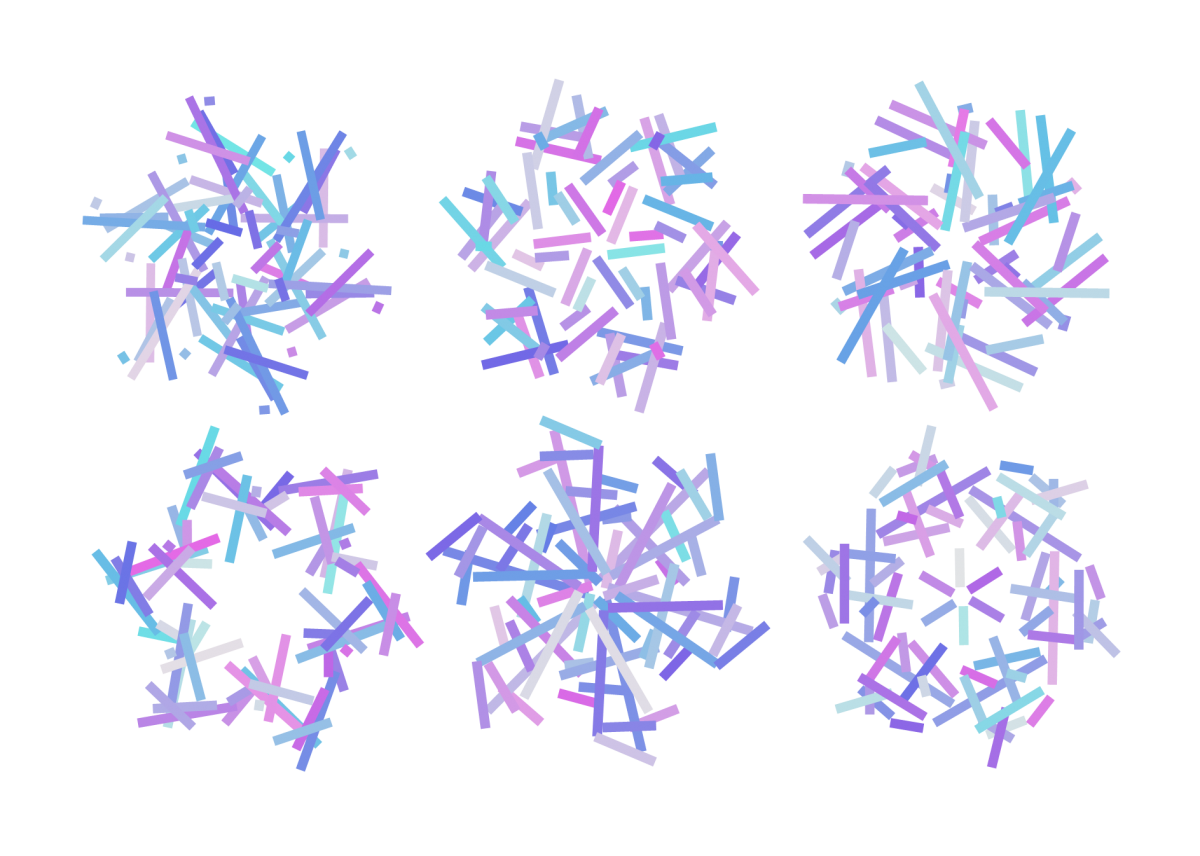
Using other functions
Of course, there's nothing that says we have to rotate only straight lines; let's try rotating other functions!
x=1:45;
x2=1:45;
y=exp(.1*x);
y2=-.2*exp(.1*x);
figure
for i=1:length(x)
plot(x(1:i),y(1:i),'Color',[.7 .7 1],'LineWidth',2)
plot(x2(1:i),y2(1:i),'Color',[.5 .5 1],'LineWidth',2)
axis off
xlim([-100,100]);
ylim([-100,100]);
hold on
pause(0.01)
end
hold on
for ang=0:30:30*22
rot=[cosd(ang), -sind(ang); sind(ang), cosd(ang)];
for i=1:length(x)
temp=[y(i);x(i)];
temp2=rot*temp;
x(i)=temp2(1);
y(i)=temp2(2);
temp=[y2(i);x2(i)];
temp2=rot*temp;
x2(i)=temp2(1);
y2(i)=temp2(2);
plot(x(1:i),y(1:i),'Color',[.7 .7 1],'LineWidth',2);
plot(x2(1:i),y2(1:i),'Color',[.5 .5 1],'LineWidth',2);
pause(0.001);
end
end

x=1:45;
x2=1:45;
y=exp(.1*x);
y2=-.2*exp(.1*x);
figure
for i=1:length(x)
plot(x(1:i),y(1:i),'Color',[.7 .7 1],'LineWidth',2)
plot(x2(1:i),y2(1:i),'Color',[.5 .5 1],'LineWidth',2)
axis off
xlim([-100,100]);
ylim([-100,100]);
hold on
pause(0.001)
end
hold on
for ang=0:20:20*40
rot=[cosd(ang), -sind(ang); sind(ang), cosd(ang)];
for i=1:length(x)
temp=[y(i);x(i)];
temp2=rot*temp;
x(i)=temp2(1);
y(i)=temp2(2);
temp=[y2(i);x2(i)];
temp2=rot*temp;
x2(i)=temp2(1);
y2(i)=temp2(2);
plot(x(1:i),y(1:i),'Color',[.7 .7 1],'LineWidth',2);
plot(x2(1:i),y2(1:i),'Color',[.5 .5 1],'LineWidth',2);
pause(0.001);
end
end
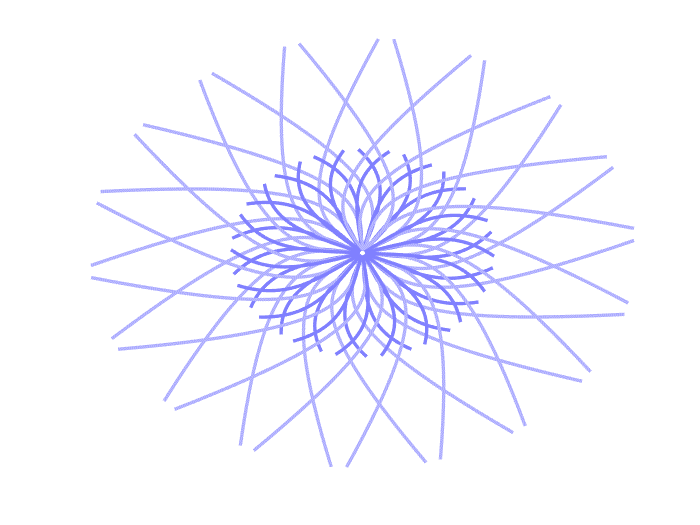
x=0:.1:1;
x2=0:.1:1;
y=x.^2;
y2=1./x;
figure
for ang=1:45:45*20
rot=[cosd(ang), -sind(ang); sind(ang), cosd(ang)];
for i=1:length(x)
temp=[y(i);x(i)];
temp2=rot*temp;
x(i)=temp2(1);
y(i)=temp2(2);
temp=[y2(i);x2(i)];
temp2=rot*temp;
x2(i)=temp2(1);
y2(i)=temp2(2);
plot(x(1:i),y(1:i),'Color',[.7 .7 1],'LineWidth',2);
axis off
xlim([-2,2]);
ylim([-2,2]);
hold on
plot(x2(1:i),y2(1:i),'Color',[.5 .5 1],'LineWidth',2);
alpha(0.5)
pause(0.001);
end
end
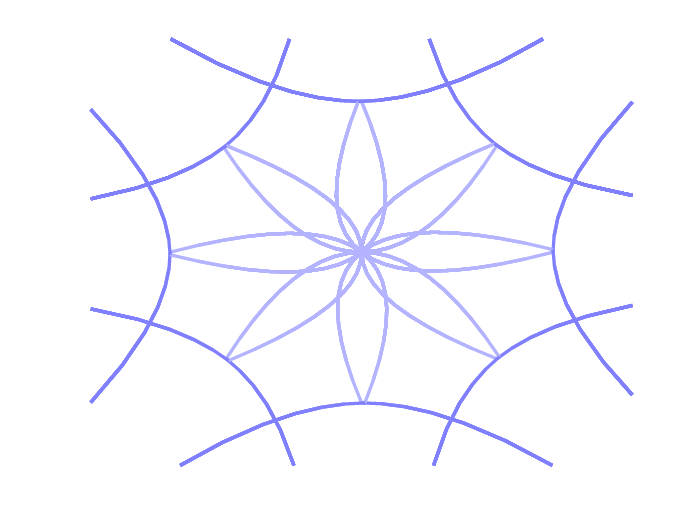
x=0:.1:1.1;
x2=0:.1:1.1;
y=x.^3;
y2=x.^5;
figure
for ang=0:45:45*16
rot=[cosd(ang), -sind(ang); sind(ang), cosd(ang)];
for i=1:length(x)
temp=[y(i);x(i)];
temp2=rot*temp;
x(i)=temp2(1);
y(i)=temp2(2);
temp=[y2(i);x2(i)];
temp2=rot*temp;
x2(i)=temp2(1);
y2(i)=temp2(2);
plot(x(1:i),y(1:i),'Color',[.7 .7 1],'LineWidth',2);
axis off
xlim([-2,2]);
ylim([-2,2]);
hold on
plot(x2(1:i),y2(1:i),'Color',[.5 .5 1],'LineWidth',2);
pause(0.001);
end
end
